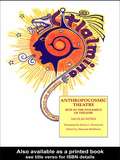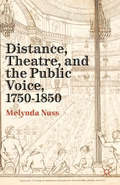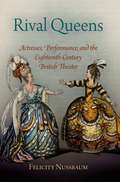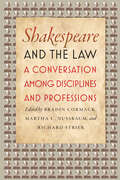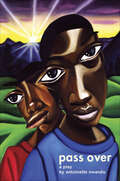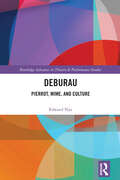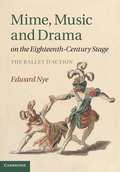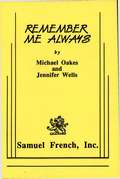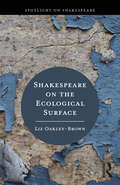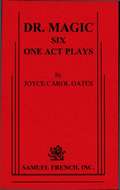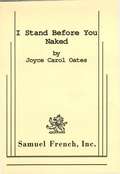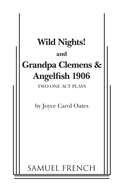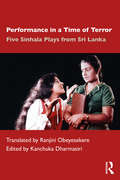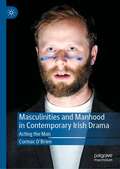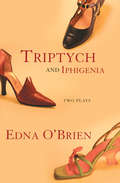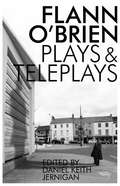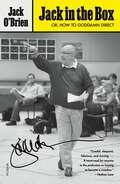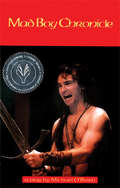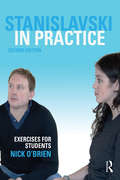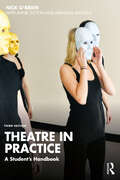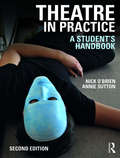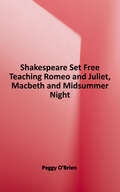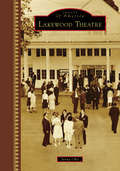- Table View
- List View
Anthropocosmic Theatre: Rite in the Dynamics of Theatre (Contemporary Theatre Studies #Vol. 13.)
by Nichos NunezFirst published in 1997. Routledge is an imprint of Taylor & Francis, an informa company.
Distance, Theatre, and the Public Voice, 1750–1850
by M. NussAs theatres expanded in the eighteenth and nineteenth centuries, the distance between actor and audience became a telling metaphor for the distance emerging between writers and readers. Nuss explores the ways in which theatre helped authors imagine connecting with a new mass audience.
Rival Queens
by Felicity NussbaumIn eighteenth-century England, actresses were frequently dismissed as mere prostitutes trading on their sexual power rather than their talents. Yet they were, Felicity Nussbaum argues, central to the success of a newly commercial theater. Urban, recently moneyed, and thoroughly engaged with their audiences, celebrated actresses were among the first women to achieve social mobility, cultural authority, and financial independence. In fact, Nussbaum contends, the eighteenth century might well be called the "age of the actress" in the British theater, given women's influence on the dramatic repertory and, through it, on the definition of femininity.Treating individual star actresses who helped spark a cult of celebrity--especially Anne Oldfield, Susannah Cibber, Catherine Clive, Margaret Woffington, Frances Abington, and George Anne Bellamy--Rival Queens reveals the way these women animated issues of national identity, property, patronage, and fashion in the context of their dramatic performances. Actresses intentionally heightened their commercial appeal by catapulting the rivalries among themselves to center stage. They also boldly rivaled in importance the actor-managers who have long dominated eighteenth-century theater history and criticism. Felicity Nussbaum combines an emphasis on the celebrated actresses themselves with close analysis of their diverse roles in works by major playwrights, including George Farquhar, Nicholas Rowe, Colley Cibber, Arthur Murphy, David Garrick, Isaac Bickerstaff, and Richard Sheridan. Hers is a comprehensive and original argument about the importance of actresses as the first modern subjects, actively shaping their public identities to make themselves into celebrated properties.
The Fragility of Goodness: Luck and Ethics in Greek Tragedy and Philosophy
by Martha C. NussbaumThis book is a study of ancient views about "moral luck. " It examines the fundamental ethical problem that many of the valued constituents of a well-lived life are vulnerable to factors outside a person's control, and asks how this affects our appraisal of persons and their lives. The Greeks made a profound contribution to these questions, yet neither the problems nor the Greek views of them have received the attention they deserve. This updated edition contains a new preface.
Shakespeare and the Law: A Conversation Among Disciplines and Professions
by Martha C. Nussbaum Richard Strier Bradin CormackWilliam Shakespeare is inextricably linked with the law. Legal documents make up most of the records we have of his life, and trials, lawsuits, and legal terms permeate his plays. Gathering an extraordinary team of literary and legal scholars, philosophers, and even sitting judges, "Shakespeare and the Law" demonstrates that ShakespeareOCOs thinking about legal concepts and legal practice points to a deep and sometimes vexed engagement with the lawOCOs technical workings, its underlying premises, and its social effects. a"Shakespeare and the Law "opens with three essays that provide useful frameworks for approaching the topic, offering perspectives on law and literature that emphasize both the continuities and contrasts between the two fields. In its second section, the book considers ShakespeareOCOs awareness of common law thinking and common law practice through examinations of "Measure for Measure" and "Othello. " Building and expanding on this question, the third part inquires into ShakespeareOCOs general attitudes toward legal systems. A judge and a former solicitor general rule on ShylockOCOs demand for enforcement of his odd contract; and two essays by literary scholars take contrasting views on whether Shakespeare could imagine a functioning legal system. The fourth section looks at how law enters into conversation with issues of politics and community, both in the plays and in our own world. The volume concludes with a freewheeling colloquy among Supreme Court Justice Stephen Breyer, Judge Richard Posner, Martha C. Nussbaum, and Richard Strier that covers everything from the ghost in "Hamlet" to the nature of judicial discretion. aCelebrating the sometimes fractious intellectual energy produced by scholars and practitioners tackling the question of Shakespeare and the law, this collection is a resource and provocation for further thinking and ongoing discussion.
Pass Over: A Play
by Antoinette NwanduA startling play examining the cyclical ravages of racial injustice and violence on two young black men, by an extraordinary voice in American theater. Moses and Kitch stand around on the corner—talking shit, passing the time, and hoping that maybe today will be different. As they dream of their promised land, a stranger wanders into their space with his own agenda and derails their plans. Emotional and lyrical, Pass Over crafts everyday profanities into poetic and humorous riffs, exposing the unquestionable human spirit of young men stuck in a cycle that they are desperately trying to escape. Spike Lee directed a film version of the play that premiered at the 2018 Sundance Film Festival and South by Southwest, and was produced by Amazon Studios. A provocative riff on the Book of Exodus and Waiting for Godot, Pass Over is a remarkable work of politically-charged theater by a bold new American voice.Praise for Pass Over &“Searing. . . . Blazingly theatrical. . . . Moses and Kitch are a dispossessed team like [Beckett&’s] Vladimir and Estragon, stuck in an existential cycle of hopelessness they try to master with gallows humor and jags of deluded optimism. . . . Creates a vivid world of injustice while riffing on earlier. . . . Resonates as a powerful tragedy.&” ―New York Time &“Chilling. . . . Combines daring near-experimental form and brutal content: what&’s at work is not some mysterious cosmic existentialism à la Beckett, but very real, very tangible racism.&” ―New Yorker &“In the insanity of a city filled with guns, and people ready and willing to use them whenever temperatures rise, waiting isn&’t so much a malaise as a badge of survival. That&’s one of the takeaways of Antoinette Nwandu&’s Pass Over, a very potent and promising play. . . . The language in the work is thrilling, poetical.&” ―Chicago Tribune
Deburau: Pierrot, Mime, and Culture (Routledge Advances in Theatre & Performance Studies)
by Edward NyeThis volume analyses the nature of the mime art of Deburau and of the pantomime performances of the Théâtre des Funambules in Paris in the context of Romantic art, literature and socio-political thought. Deburau and the Théâtre des Funambules are characteristic of Romantic art in that they are closely associated with certain aspirations for social reform, even revolution. Deburau was an iconic figure for intellectuals such as George Sand who effectively considered him to be part of the ‘poète-maçon’ movement. Edward Nye examines this fascination as well as the myth which developed from it. With its unique framing in art, literature and politics, this book is a must read for undergraduates and postgraduates in theatre, literary studies, and the Romantic period.
Mime, Music and Drama on the Eighteenth-Century Stage
by Edward Nye"The 'ballet d'action' was one of the most successful and controversial forms of theatre in the early modern period. A curious hybrid of dance, mime and music, its overall and overriding intention was to create drama. It was danced drama rather than dramatic dance, musical drama rather than dramatic music. Most modern critical studies of the ballet d'action treat it more narrowly as stage dance and very few view it as part of the history of mime. Little use has previously been made of the most revealing musical evidence. This innovative book does justice to the distinctive hybrid nature of the ballet d'action by taking a comparative approach, using contemporary literature and literary criticism, music, mime and dance from a wide range of English and European sources. Edward Nye presents a fascinating study of this important and influential part of eighteenth-century European theatre"--
Remember Me Always
by Michael OakesComedy/Drama / 4m, 5f / Interior / The chairperson of the Senior So Long Dance enlists eight students to decorate. As they transform the gym (stage) with streamers, stars and balloons, they learn about each other and themselves. Day turns to night, the dance begins and they pledge to remember all they've been through. Developed with teenagers in the Drama Workshop of the Greenwich Village Youth Council in New York, Remember Me Always captures the voice of today's youth.
Shakespeare on the Ecological Surface (Spotlight on Shakespeare)
by Liz Oakley-BrownShakespeare on the Ecological Surface uses the concept of the ‘surface’ to examine the relationship between contemporary performance and ecocriticism. Each section looks, in turn, at the 'surfaces' of slick, smoke, sky, steam, soil, slime, snail, silk, skin and stage to build connections between ecocriticism, activism, critical theory, Shakespeare and performance. While the word ‘surface’ was never used in Shakespeare’s works, Liz Oakley-Brown shows how thinking about Shakespearean surfaces helps readers explore the politics of Elizabethan and Jacobean culture. She also draws surprising parallels with our current political and ecological concerns. The book explores how Shakespeare uses ecological surfaces to help understand other types of surfaces in his plays and poems: characters’ public-facing selves; contact zones between characters and the natural world; surfaces upon which words are written; and physical surfaces upon which plays are staged. This book will be an illuminating read for anyone studying Shakespeare, early modern culture, ecocriticism, performance and activism.
Dr. Magic: Six One Act Plays
by Joyce Carol OatesContents: Homesick Dr. Magic Here She Is! Negative The Adoption When I was a Little Girl and My Mother Didn't Want Me
I Stand Before You Naked
by Joyce Carol OatesMonologues / 11f / Bare Stage / This extraordinary collection of dramatic monologues by one of America's foremost women of letters rivals Talking With in dramatic intensity, language and sheer weirdness. The evening begins and ends with the title poem, a haunting evocation of woman on the edge of madness and vulnerability. Also included are Little Blood Button; Wife of; Wealthy Lady; The Boy; The Orange; Good Morning, Good Afternoon; Darling, I'm Telling You (Angel Eyes); Nuclear Holocaust; Slow Motion and Pregnant. There is humor here, but mostly the monologues are gripping portraits of the pathetic, the strange, and the horrifying.
Wild Nights! & Grandpa Clemens and Angelfish 1906
by Joyce Carol OatesDramatic Comedy / 2m, 2f / Wild Nights! is a matched duo of plays about Emily Dickinson and Samuel Clemens/Mark Twain—adapted from a prose work described by the New York Times as “morality tales about sexual power” that “ingeniously” imagine the last days of classic American writers whose true, private lives are unknown to the public.
Performance in a Time of Terror: Five Sinhala Plays from Sri Lanka
by Ranjini Obeyesekere Kanchuka DharmasiriThis volume is a collection of five Sinhala plays, translated into English, which were written and performed during the most violent phase of modern Sri Lankan history. Ranjini Obeyesekere’s translation of these five well-known and celebrated plays by K. B. Herath, Prasannajith Abeysuriya, Dhananjaya Karunarathne, Prasanna Jayakody and Rajitha Dissanayake highlights and explores the dynamic period of Sri Lankan theater and performance arts in the 1980s and 1990s. The plays in this collection offered a political space for criticism, introspection, discussion and protest during a time of suppression of voices, political violence and terror. Audiences flocked to the theater to watch plays produced by talented dramatists and artists who were experimenting with forms and themes under extremely challenging circumstances, shoe-string budgets and strict censorship. Kanchuka Dharmasiri’s introduction to the volume further details the history and socio-political contexts of the theater of this period, discussing themes such as dissent, identity and the brutal power of the state. She also looks at the unique formal elements employed in these plays as well as their influence and reach. This volume is a significant addition to the growing corpus of Sinhala literature in translation. It will be an essential read for scholars and researchers of literature, performance studies, cultural studies, and the politics and history of Sri Lanka.
Masculinities and Manhood in Contemporary Irish Drama: Acting the Man
by Cormac O'BrienThis book charts the journey, in terms of both stasis and change, that masculinities and manhood have made in Irish drama, and by extension in the broader culture and society, from the 1960s to the present. Examining a diverse corpus of drama and theatre events, both mainstream and on the fringe, this study critically elaborates a seismic shift in Irish masculinities. This book argues, then, that Irish manhood has shifted from embodying and enacting post-colonial concerns of nationalism and national identity, to performing models of masculinity that are driven and moulded by the political and cultural practices of neoliberal capitalism. Masculinities and Manhood in Contemporary Irish Drama charts this shift through chapters on performing masculinity in plays set in both the Irish Republic and Northern Ireland, and through several chapters that focus on Women’s and Queer drama. It thus takes its readers on a journey: a journey that begins with an overtly patriarchal, nationalist manhood that often made direct comment on the state of the nation, and ultimately arrives at several arguably regressive forms of globalised masculinity, which are couched in misaligned notions of individualism and free-choice and that frequently perceive themselves as being in crisis.
Triptych and Iphigenia: Two Plays (Books That Changed the World)
by Edna O'BrienTwo plays by the acclaimed Irish author: an adaption of Euripides and an “emotionally bruising drama” of three women obsessed with the same man (The New York Times).TriptychWith searing acuity, O’Brien presents the story of three women—a mistress, a wife, and a daughter—who are all helplessly drawn to Henry: their lover, husband, and father. While Henry himself never appears, his specter is never absent as these women confront the ways that love can simultaneously liberate and entrap. Triptych is a powerful work that explores sex, marriage, and predatory relationships.IphigeniaIn this modern take on the Greek tragedy, O’Brien takes creative license with Euripides’s tale of a daughter sacrificed for the sake of war. This taut, contemporary version presents, in O’Brien’s own words, “a more equal representation of the power and presence of both male and female characters” (Edna O’Brien, Independent, UK).“Intriguingly original . . . emotionally brave and engagingly clever.” –R. Hurwitt, The San Francisco Chronicle
Collected Plays and Teleplays
by Flann O'Brien Daniel Keith JerniganIn the same spirit as his novels, O'Brien's plays are speculative, inventive, wickedly funny, and a delightful addition to his collected works--now available at last: this volume collects Flann O'Brien's dramatic work into a single volume, including Thirst, Faustus Kelly, and The Insect Play: A Rhapsody on Saint Stephen's Green. It also includes several plays and teleplays that have never before seen print, including The Dead Spit of Kelly (of which a film version is in production by Michael Garland), The Boy from Ballytearim, and An Scian (only recently discovered), as well as teleplays from the RTÉ series O'Dea's Your Man and Th'oul Lad of Kilsalaher.
Collected Plays and Teleplays
by Flann O'Brien Daniel Keith JerniganIn the same spirit as his novels, O'Brien's plays are speculative, inventive, wickedly funny, and a delightful addition to his collected works--now available at last: this volume collects Flann O'Brien's dramatic work into a single volume, including Thirst, Faustus Kelly, and The Insect Play: A Rhapsody on Saint Stephen's Green. It also includes several plays and teleplays that have never before seen print, including The Dead Spit of Kelly (of which a film version is in production by Michael Garland), The Boy from Ballytearim, and An Scian (only recently discovered), as well as teleplays from the RTÉ series O'Dea's Your Man and Th'oul Lad of Kilsalaher.
Jack in the Box: or, How to Goddamn Direct
by Jack O'BrienThe Tony Award–winning director gathers memories of people, productions, and problems surmounted from his fifty-year career in this one-of-a-kind how-to handbook.What do directors do? Jack O’Brien, the winner of Tony and Drama Desk Awards and the former artistic director of San Diego’s historic Old Globe theatre, describes it like this: “You stand before a situation in which something is presented to you. You’re afforded a challenge. Like catching an enormous ball. And you respond. You come up with a vision of some kind. That is, if you respond to the material at all, and one must, or it’s doomed. You sort of feel that since you relate to the material at hand, you might as well try to be helpful.”In Jack in the Box, O’Brien’s follow-up to his memoir Jack Be Nimble, the director collects stories from the many productions he has worked on, the great talents he encountered and collaborated with (including Tom Stoppard, Mike Nichols, Jerry Lewis, Marsha Mason, and many others), and the choices he made, on the stage and off, that have come to define his career. With humor, warmth, and contagious excitement, O’Brien takes the reader by the shoulder, pulls them in, and tells them how to become a director—or, at the very least, relates an unfailingly honest story of how he did.
Mad Boy Chronicle
by Michael O'Brien Liz NichollsSet in the final days of the first millennium, Mad Boy Chronicle hauls the Hamlet story howling back to its origins. Join the Mad Boy as he sets out in fierce pursuit of his destiny, in a world where wolves, elves, spirits, and Jesus Christ all compete for the future of humanity.
Stanislavski in Practice: Exercises for Students
by Nick O'BrienStanislavski in Practice is an unparalleled step-by-step guide to Stanislavski’s system. Author Nick O’Brien makes this cornerstone of acting accessible to teachers and students alike through the use of practical exercises that allow students to develop their skills. This second edition offers more exercises for the actor, and also new sections on directing and devising productions. Each element of the system is covered practically through studio exercises and jargon-free discussion. Exercises are designed to support syllabi from Edexcel, Eduqas, OCR and AQA to the practice-based requirements of BTEC and IB Theatre. This is the perfect exercise book for students and a lesson planner for teachers at post-16 and first year undergraduate level. New to this edition: Thoroughly reorganized sections, including 'Work on the Actor', 'Work on a Role' and 'Developing your Practice'; A new chapter on using Stanislavski when devising with a series of exercises that will allow students to structure and create characters within the devising process; A new chapter, Directing Exercise Programme, which will be a series of exercises that allows the student to develop their skills as a director; New glossary with US and UK terms; New exercises developed since the publication of the first edition; A new chapter going beyond Stanislavski, exploring exercises from Michael Chekhov, Maria Knebel and Katie Mitchell.
Theatre in Practice: A Student's Handbook
by Nick O'BrienTheatre in Practice, third edition, is an accessible and wide-ranging exploration of the central practices and key practitioners covered on the various syllabi at A level, IB, and at undergraduate level.Exploring Stanislavski, Brecht, Artaud, Lecoq, Berkoff, Bogart, Mitchell and Craig, as well as work from innovative theatre companies such as Tamasha, Sh!T Theatre, Complicite, Gecko and The Paper Birds, it combines an informal, unpretentious tone with a wealth of practical exercises. Revised and updated to include some of the latest practices in theatre, this new edition offers a step-by-step approach to developing key skills such as devising, improvising, rehearsing mono/duologues and directing plays.New for this edition are chapters from Nick O'Brien and Mikhaela Mahony on key female and global majority practitioners; a chapter offering a unique insight into the acting practice of award-winning actress Indira Varma; and updated information throughout.Written by specialists with extensive experience at post-16 and undergraduate level, Theatre in Practice is a thorough and imaginative resource that speaks directly to students and teachers. This book offers students a range of exercises to experience and explore key practitioners enabling them to understand theatre how it should be understood: through practice.
Theatre in Practice: A Student's Handbook
by Nick O'Brien Annie SuttonTheatre in Practice is an accessible and wide-ranging exploration of the central practices and key practitioners covered on the various syllabi at A level, IB, BTEC and beyond. Exploring Stanislavski, Brecht, Artaud, Lecoq, Berkoff and Craig, as well as work from innovative theatre companies such as Complicite, Gecko and The Paper Birds, it combines an informal, unpretentious tone with a wealth of practical exercises. Revised and updated to meet the most recent post-16 and A level drama requirements and to include some of the latest practices in theatre, this new edition offers a step-by-step approach to developing key skills such as devising, improvising, rehearsing mono/duologues and directing plays. Written by specialists with extensive experience leading workshops for the post-16 age-group, Theatre in Practice is a thorough and imaginative resource that speaks directly to students. New for this edition: A new chapter exploring Artaud and how to use Artaud with text and when devising. A new chapter exploring the progression of practice from Lecoq to Complicite. A series of step-by-step exercises exploring the Gecko devising process. An exploration of the work of The Paper Birds and E G Craig when devising. New exercises on how to devise using Stanislavski and Brecht.
Teaching a Midsummer Night's Dream, Romeo and Juliet, and Macbeth: Shakespeare Set Free (Folger Shakespeare Library)
by Peggy O'BrienThe Folger Shakespeare Library, the nation's most important center for Shakespeare study and scholarship, is also the center for Shakespeare education. At the Library's Teaching Shakespeare Institute, scholars, actors, and teachers from across the country work together in the business of teaching and learning Shakespeare. This volume of the Shakespeare Set Free series is written by institute faculty and participants and includes the latest developments in recent scholarship. It bristles with the energy created by teaching and learning Shakespeare from the text and through active performance and reflects the experience, wisdom, and wit of real classroom teachers in schools and colleges throughout the United States. In this book, you will find the following:-Clearly written essays by leading scholars to refresh teachers and challenge older students -Michael Tolaydo’s brilliant and accessible technique for classroom teaching through performance -Day-by-day teaching strategies that successfully and energetically immerse students in every grade and skill level in the language and the plays themselves – created, taught, and written by real teachers.
Lakewood Theatre (Images of America)
by Jenny ObyBeginning as a humble vaudeville hall in the Skowhegan-Madison trolley park, Lakewood Theatre has graced the southwestern shore of Lake Wesserunsett in Madison, Maine, since the turn of the 20th century. Under the masterful guidance of Herbert L. Swett, a Bangor native and Bowdoin graduate, Lakewood eventually developed into a nationally renowned playhouse that was called the “Broadway in Maine” by the New York Times in its heyday, from 1925 until World War II. In the years following the war, Lakewood was operated by Swett’s heirs and became a virtual who’s who of both Broadway and Hollywood, until it nearly went dark in the early 1980s. Operating today as a nonprofit community theater, Lakewood is the official state theater of Maine and the oldest continually running summer theater in the country.
